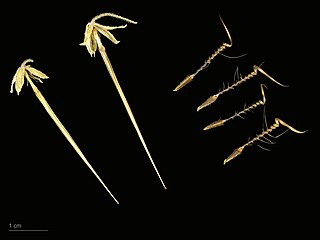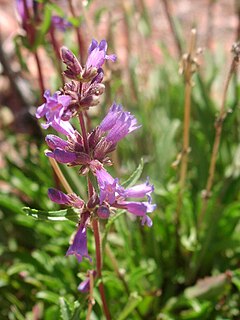
Erodium moschatum is a species of flowering plant in the geranium family known by the common names musk stork's-bill and whitestem filaree. This is a weedy annual or biennial herb which is native to much of Eurasia and North Africa but can be found on most continents where it is an introduced species. The young plant starts with a flat rosette of compound leaves, each leaf up to 15 centimeters long with many oval-shaped highly lobed and toothed leaflets along a central vein which is hairy, white, and stemlike. The plant grows to a maximum of about half a meter in height with plentiful fuzzy green foliage. The small flowers have five sepals behind five purple or lavender petals, each petal just over a centimeter long. The filaree fruit has a small, glandular body with a long green style up to 4 centimeters in length.
Erysimum teretifolium is a species of Erysimum known by the common names Santa Cruz wallflower and Ben Lomond wallflower. It is a very rare plant endemic to Santa Cruz County, California, where it grows on inland sand spits, chaparral, and sandstone deposits in the southern Santa Cruz Mountains. It is a California state and federally listed endangered species.
Guillenia flavescens is a species of mustard plant known by the common name yellow mustard, but it is not the only species known by that name. Sinapis alba is probably the plant more widely known as yellow mustard. G. flavescens is a thin-stemmed annual herb growing large, lobed or toothed leaves up to 22 centimeters long around its base, and smaller, less toothed leaves along its gray-pink to brown stem. At intervals along the upper stem appear cream, yellowish, or very pale purple flowers, each somewhat cuboid in shape and about a centimeter long. The tips of the petals around the mouth are curled, flared, or clawlike. The fruit is a thin silique up to 9 centimeters long. This species is endemic to California, where it grows in the valleys and mountains surrounding the San Francisco Bay Area.

Arctostaphylos glauca is a species of manzanita known by the common name bigberry manzanita. It is native to California and Baja California, where it grows in the chaparral and woodland of coastal and inland hills.

Ammannia coccinea is a species of flowering plant in the loosestrife family known by several common names, including valley redstem, scarlet toothcup, and purple ammannia. It is native to most of the contiguous United States, with the exception of the Pacific Northwest and New England. It is generally found in moist areas, such as riverbanks and pond margins. It is weedy in some areas. This is an annual herb growing erect to heights approaching one meter or lying along the ground. Leaves are linear in shape, up to 8 centimeters long, and green to shades of deep red in color. The inflorescence is a cluster of 3 to 5 flowers growing in the leaf axils along the upper part of the stem. The rounded flower has small rose to lavender petals each a few millimeters long and protruding stamens with yellow anthers. The fruit is a rounded capsule up to half a centimeter wide containing many tiny seeds.

Astragalus agnicidus is a rare species of milkvetch known by the common name Humboldt County milkvetch. It is endemic to northern California, where it is known only from two populations in Humboldt County and one in Mendocino County.

Dysphania multifida is a species of flowering plant in the family Amaranthaceae known by the common names cutleaf goosefoot and scented gooosefoot.

Lythrum portula is a species of flowering plant in the loosestrife family known by the common names water-purslane and spatulaleaf loosestrife. It is native to Europe, and it is found in parts of western North America as an introduced species. It often grows in moist habitat, such as marshes. This is a prostrate annual herb producing a hairless, reddish stem up to 25 centimeters long which lies along the ground and roots where its nodes come in contact with wet earth. The slightly fleshy, spoon-shaped leaves are about a centimeter long and greenish to reddish in color. Solitary flowers occur in leaf axils. Flowers often have white or pink petals about a millimeter long, but some lack petals. The fruit is a spherical capsule containing minute seeds.
Erythranthe inconspicua, synonym Mimulus inconspicuus, is an uncommon species of monkeyflower known by the common name smallflower monkeyflower.
Pseudobahia bahiifolia is a rare species of flowering plant in the family Asteraceae known by the common name Hartweg's golden sunburst.
Psilocarphus elatior is a species of flowering plant in the family Asteraceae known by the common names tall woollyheads, meadow woollyheads and tall woolly-marbles. It is native to the Pacific Northwest in western North America from Vancouver Island, where it is known from just a few occurrences, to northern California. It grows in seasonally moist spots such as meadows, spring seeps, and vernal pools.

Pyrrocoma apargioides is a species of flowering plant in the family Asteraceae known by the common name alpineflames. It is native to the western United States from the Sierra Nevada of California east to Utah, where it grows in the forests and meadows of high mountains. It is a perennial herb growing from a taproot and producing one or more stems to 30 centimeters in length. The stems are decumbent or upright, reddish, and hairless to slightly woolly. Most of the leaves are located around the base. They are thick and leathery, lance-shaped with large sawteeth along the edges, often center-striped in white, and measure up to 10 centimeters long. The inflorescence is usually a single flower head lined with centimeter-long phyllaries which are reddish to green with red edges. The head has a center of yellow disc florets and a fringe of ray florets which are yellow, often splashed with red along the undersides, measuring up to 1.6 centimeters in length. The fruit is an achene which may be well over a centimeter in length including its pappus.

Raillardella argentea is a species of flowering plant in the family Asteraceae known by the common name silky raillardella. It is native to the Sierra Nevada and nearby mountain ranges of California, its distribution extending east into Nevada and north along the Cascade Range and Klamath Mountains into Oregon. It grows in many types of dry, open mountain habitat. It is a rhizomatous perennial herb growing in a clump of rosetted basal leaves. The leaves are lance-shaped, up to 8 centimeters long, and coated in silky hairs. The plant produces an inflorescence up to about 15 centimeters tall consisting of a solitary flower head which is cylindrical to somewhat bell-shaped. The head is enclosed in the fused outer scales of the flowers, which look similar to the phyllaries of many other species' flower heads. The head contains many yellow disc florets up to a centimeter long each, and no ray florets. The fruit is a long, narrow achene which may be 2 centimeters in length including its plumelike pappus.

Rudbeckia californica is a species of flowering plant in the family Asteraceae, known by the common name California coneflower.
Streptanthus barbiger is a species of flowering plant in the mustard family known by the common name bearded jewelflower. It is endemic to California, where it is limited to the North Coast Ranges. It grows in woodlands and chaparral habitat, often on serpentine soils. It is an annual herb producing a branching stem up to about 80 centimeters in maximum height. Leaves near the base of the stem are lance-shaped to oval and pointed, usually with toothed edges, the blades measuring up to 7 centimeters long. Leaves higher on the stem may be longer but are narrower and have smooth edges. Flowers occur at intervals along the upper stem. Each has a spherical to urn-shaped calyx of greenish yellow or purple sepals under a centimeter long. Whitish or purple-tinged petals up to a centimeter long emerge from the tip. The fruit is a long, flat, curving silique which may be 7 centimeters in length.
Streptanthus fenestratus is an uncommon species of flowering plant in the mustard family known by the common name Tehipite Valley jewelflower.

Streptanthus oliganthus is an uncommon species of flowering plant in the mustard family known by the common name Masonic Mountain jewelflower. It is native to western Nevada and eastern California, where it grows in the rocky hills east of the central Sierra Nevada. Its habitat includes forest, woodland, sagebrush, and mountain talus. It is a rhizomatous perennial herb producing a hairless, waxy, usually unbranched stem up to about 40 or 50 centimeters in maximum height. The basal leaves have lance-shaped, smooth-edged blades up to 10 centimeters long borne on fuzzy to rough-haired petioles. Leaves higher on the stem have shorter blades which may clasp the stem at their bases. Flowers occur at intervals along the upper stem. Each has a bell-shaped calyx of purple sepals no more than a centimeter long. The petals emerging from the tip are reddish purple or purple-tipped. The fruit is a smooth, flat, straight or slightly curved silique up to 8 to 10 centimeters long.

Penstemon pinorum is a rare species of flowering plant in the plantain family known by the common names Pine Valley penstemon and pinyon penstemon. It is endemic to Utah in the United States, where it is known only from an area along the border between Washington and Iron Counties.
Agave phillipsiana is a rare species of flowering plant in the asparagus family known by the common names Grand Canyon century plant and Phillips agave. It is endemic to Arizona in the United States, where it lives only in Grand Canyon National Park. It is a perennial herb or shrub.

Sericocarpus rigidus is a species of flowering plant in the family Asteraceae known by the common name Columbian whitetop aster. It is native to the Pacific Northwest of North America, where it is known from southern Vancouver Island in British Columbia south along the coast to Washington and Oregon.













